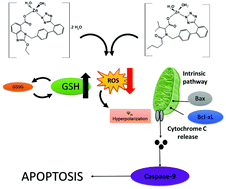Candesartan and valsartan Zn(ii) complexes as inducing agents of reductive stress: mitochondrial dysfunction and apoptosis†
Abstract
Cellular oxidative stress is considered an inducer of carcinogenesis but the association of reactive oxygen species (ROS) with cancer is sometimes contradictory. The antihypertensive drugs candesartan and valsartan were reported to behave as antioxidant agents. In the present study, we prepared their Zn(II) coordination complexes, [ZnCand(H2O)2]·2H2O (ZnCand) and [ZnVals(H2O)2] (ZnVals), and determined that they also depleted ROS by the induction of a reductive state in response to glutathione (GSH) generation and decreased lung cancer cell viability (IC50 = 175 and 220 µM, respectively), while being non-cytotoxic for normal lung fibroblasts (MRC5). The Zn complexes affected the mitochondria membrane, increased the pro- and anti-apoptotic protein ratio, Bax/Bcl-XL, and caspase-9 activation, by late apoptosis. Their co-incubation with N-acetylcysteine (NAC) exacerbated ROS reduction and increased cell death, whereas the H2O2 co-treatment restored the ROS values and normal cell growth. These data suggest that the excess reducing equivalents and low levels of ROS are also critical for the functioning of A549 cells.



 Please wait while we load your content...
Please wait while we load your content...